Basic Obedience Training for Dogs
137048 Views, 183 Favorites, 0 Comments
Basic Obedience Training for Dogs

Mastering basic obedience commands is a vital part of being a responsible dog owner. These basic commands make navigating the relationship between animal and owner much easier and keep both you and your pet safe in emergency situations.
From an outsider's perspective, basic training can look either very simple or extremely difficult. Recognize that training can take a lot of work. Also recognize any dog can learn at least the most basic and necessary commands. Dog owners occasionally run into road blocks when training, don't become frustrated. Seeking assistance from a professional trainer benefits first-time owners or individuals struggling with teaching commands or correcting problem behaviors. Don't ever hesitate to ask for help!
Training takes a lot of time and patience, even if you aren't trying any complicated or 'fancy' tricks. The responsibility of pet ownership includes properly training and socializing your animal. Before considering adopting an animal, please take into account how much time you will need to dedicate to making sure you have a happy, healthy, well-socialized and well-trained animal.
Finally, dog ownership and even training should be fun! Don't be too serious and make sure both you and your pet have a good time so you will look forward to future sessions!
From an outsider's perspective, basic training can look either very simple or extremely difficult. Recognize that training can take a lot of work. Also recognize any dog can learn at least the most basic and necessary commands. Dog owners occasionally run into road blocks when training, don't become frustrated. Seeking assistance from a professional trainer benefits first-time owners or individuals struggling with teaching commands or correcting problem behaviors. Don't ever hesitate to ask for help!
Training takes a lot of time and patience, even if you aren't trying any complicated or 'fancy' tricks. The responsibility of pet ownership includes properly training and socializing your animal. Before considering adopting an animal, please take into account how much time you will need to dedicate to making sure you have a happy, healthy, well-socialized and well-trained animal.
Finally, dog ownership and even training should be fun! Don't be too serious and make sure both you and your pet have a good time so you will look forward to future sessions!
What You Will Need



1. A dog!
2. An area in which to practice where it is free from distractions when you are first training your dog. As you and your dog master commands, you will want to move to areas with more distractions, such as outdoors, to continue improving your dog's ability to focus on you and the commands.
3. Treats or a toy as rewards. Figure out what works for you and your dog. Some dogs are very food driven, and some dogs prefer toys and play as their reward. Additionally, consider the size of treats you use during training! Treats that are too large fill a dog up quickly, so seek out small treats for training.
4. A short leash, and a longer training leash for distance work.
5. Realistic expectations!
2. An area in which to practice where it is free from distractions when you are first training your dog. As you and your dog master commands, you will want to move to areas with more distractions, such as outdoors, to continue improving your dog's ability to focus on you and the commands.
3. Treats or a toy as rewards. Figure out what works for you and your dog. Some dogs are very food driven, and some dogs prefer toys and play as their reward. Additionally, consider the size of treats you use during training! Treats that are too large fill a dog up quickly, so seek out small treats for training.
4. A short leash, and a longer training leash for distance work.
5. Realistic expectations!
- Don't expect to get it done on the first few tries. Some commands take a lot of time to teach and perfect.
- Try to make training sessions about 15 minutes long at the most.
- There will be times when both you and your dog are frustrated. When struggling with a certain command, simply move on to another or better known command. Come back to the one you are struggling with later.
- ALWAYS end training on a positive note. This keeps training sessions fun for you and your pet. Next time, your dog will be excited when it is time to practice!
Sit Command

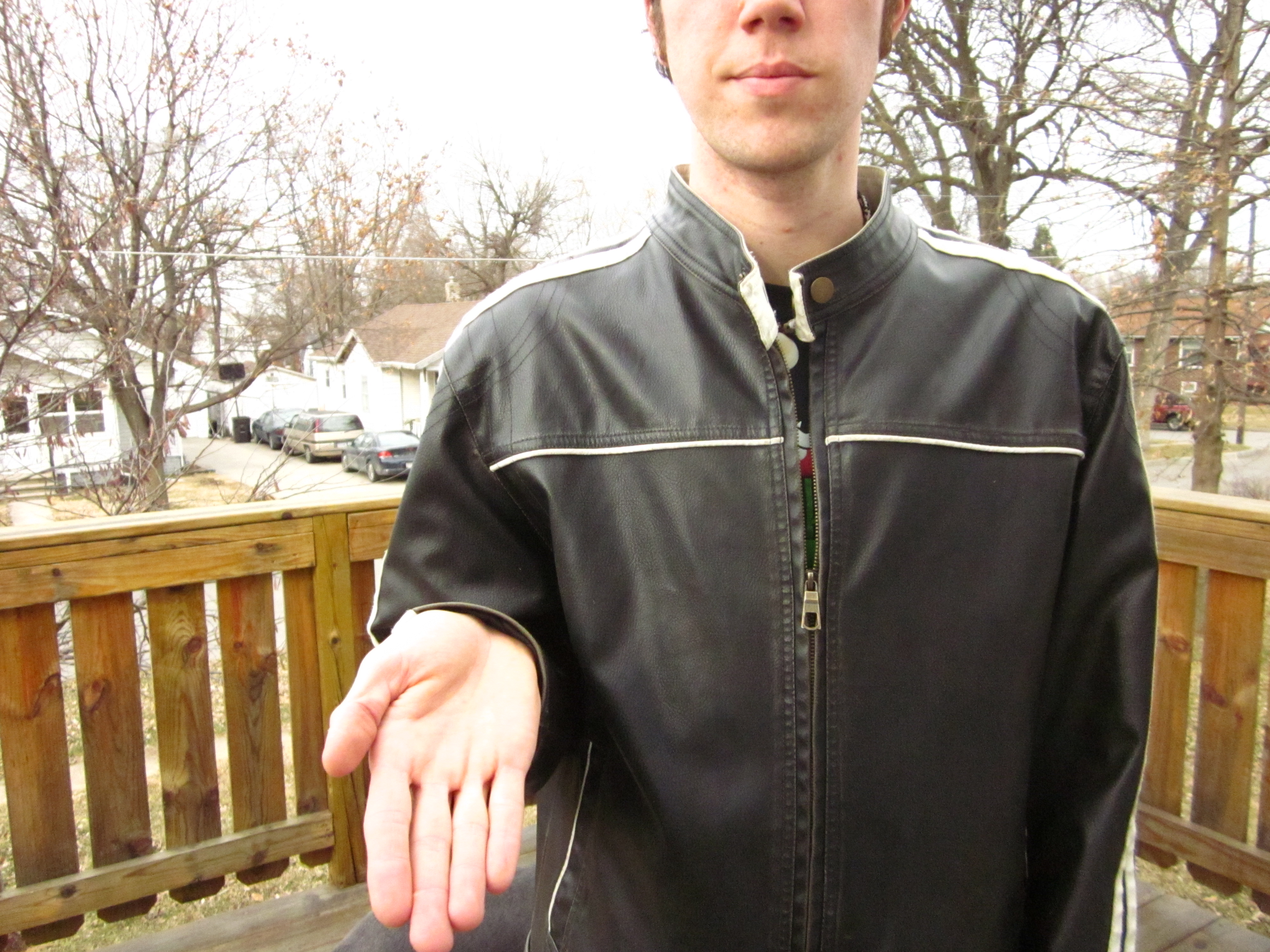

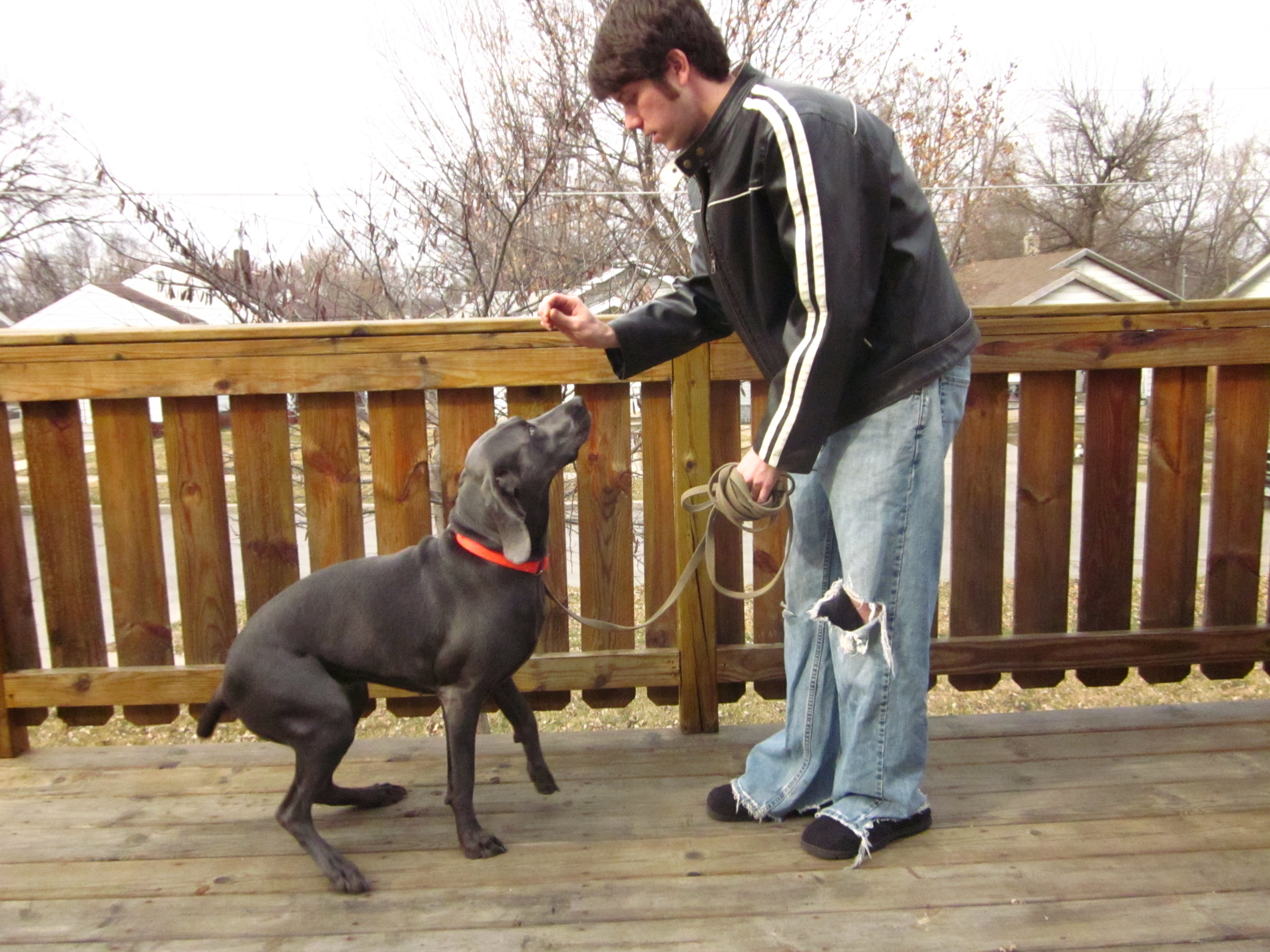

1. Make sure you have your dog's attention and a treat in hand. Stand or kneel in front of your dog and hold your hand a little higher than your dog's head.
2. Use the treat to guide your dog into position by slowly moving the treat straight back over the dog's head and towards the tail. Your dog should point his nose up and his rear should drop towards the ground.
3. As the dog moved into the sit position firmly say 'Sit' and make the hand signal shown in Picture 2.
4. As soon as the dog moves into position reward your dog with a treat and some praise, like saying, 'Good sit!'
5. If your dog is having trouble understanding, you can help guide them with a gentle pet down their back or light taps with your fingers at their hip to help hint at what you're asking as you continue to guide them with your treat. Do not apply pressure or push them into position.
(*Please note at one time I advocated for giving a gentle push on the hips, however as I have grown as a dog owner I also learned that it is better to avoid this action for a variety of reasons, including potential undetected sensitivity or pain a dog may experience.
I have found it is unnecessary to apply more than a gentle petting or pointing at the area of action to help clue a dog in to what you're looking to achieve.
If you continue to struggle I recommend seeking out a professional trainer who uses gentle training and positive reinforcement techniques.)
2. Use the treat to guide your dog into position by slowly moving the treat straight back over the dog's head and towards the tail. Your dog should point his nose up and his rear should drop towards the ground.
3. As the dog moved into the sit position firmly say 'Sit' and make the hand signal shown in Picture 2.
4. As soon as the dog moves into position reward your dog with a treat and some praise, like saying, 'Good sit!'
5. If your dog is having trouble understanding, you can help guide them with a gentle pet down their back or light taps with your fingers at their hip to help hint at what you're asking as you continue to guide them with your treat. Do not apply pressure or push them into position.
(*Please note at one time I advocated for giving a gentle push on the hips, however as I have grown as a dog owner I also learned that it is better to avoid this action for a variety of reasons, including potential undetected sensitivity or pain a dog may experience.
I have found it is unnecessary to apply more than a gentle petting or pointing at the area of action to help clue a dog in to what you're looking to achieve.
If you continue to struggle I recommend seeking out a professional trainer who uses gentle training and positive reinforcement techniques.)
Down Command




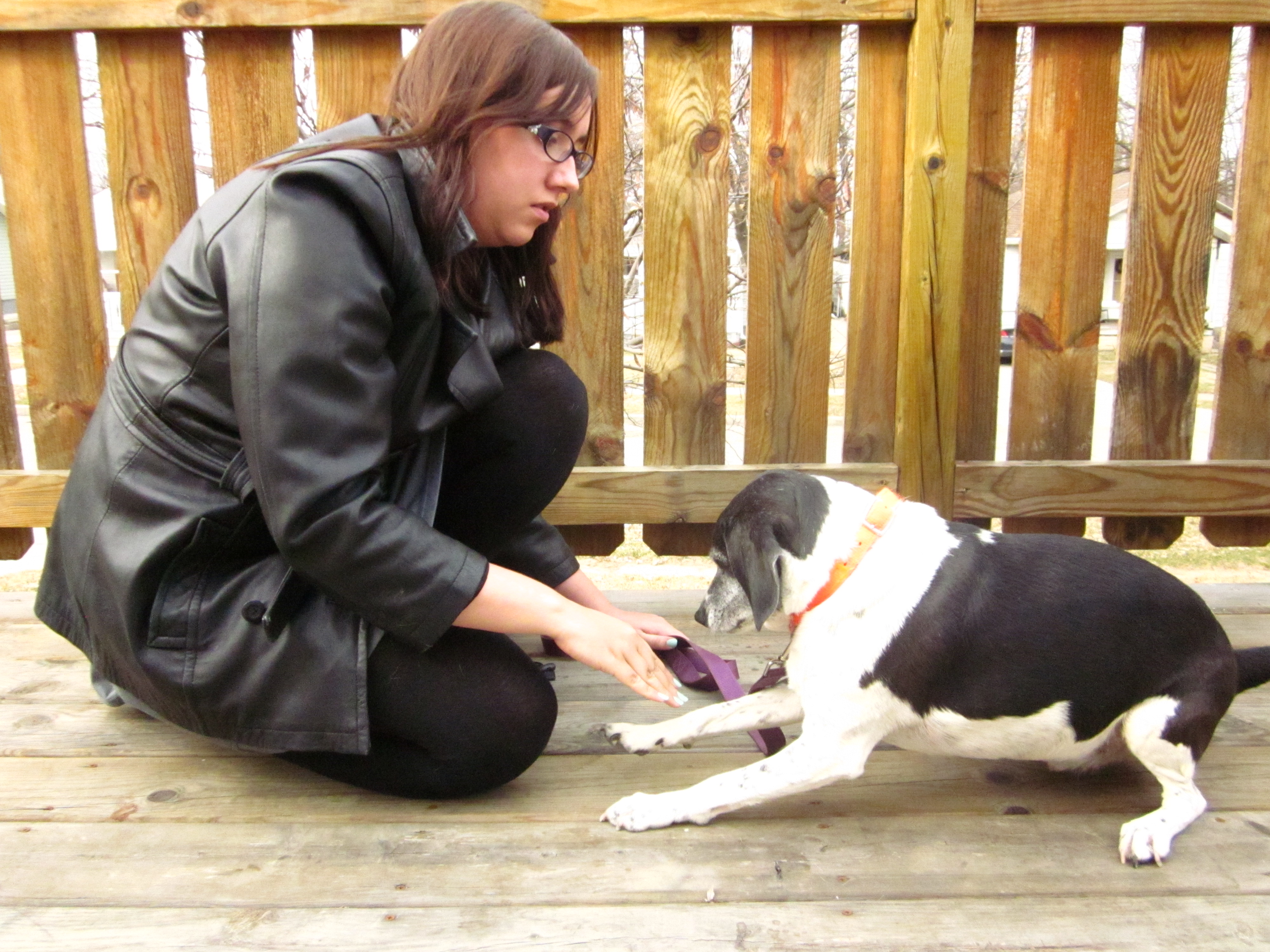

For this trick, your dog should already know the Sit command. This command can be a little more difficult to master because it is a very submissive position for your dog to take.
1. With your dog in the Sit position, kneel in front of your dog.
2. Hold a treat in front of your dog's nose and guide him by lowering the treat slowly to the ground. Firmly say 'Down' and make the hand gesture shown in Picture 2.
3. As your dog moves downwards he may only slouch. If this happens, move the treat towards or away from your dog as needed to further guide him.
4. As soon as your dog is down in the correct position, reward him with a treat and praise.
5. If you are having trouble guiding your dog into the Down position, you can physically guide him by placing a hand on your dog's shoulders and gentle tapping to hint at what you're asking. Repeat the command and continue to guide with a treat. Never press a dog into position. Praise your dog as soon as he drops to the floor.
(*Please note at one time I advocated for giving a gentle push on the the shoulders, however as I have grown as a dog owner I also learned that it is better to avoid this action for a variety of reasons, including potential undetected sensitivity or pain a dog may experience.
I have found it is unnecessary to apply more than a gentle petting or pointing at the area of action to help clue a dog in to what you're looking to achieve.
If you continue to struggle I recommend seeking out a professional trainer who uses gentle training and positive reinforcement techniques.)
1. With your dog in the Sit position, kneel in front of your dog.
2. Hold a treat in front of your dog's nose and guide him by lowering the treat slowly to the ground. Firmly say 'Down' and make the hand gesture shown in Picture 2.
3. As your dog moves downwards he may only slouch. If this happens, move the treat towards or away from your dog as needed to further guide him.
4. As soon as your dog is down in the correct position, reward him with a treat and praise.
5. If you are having trouble guiding your dog into the Down position, you can physically guide him by placing a hand on your dog's shoulders and gentle tapping to hint at what you're asking. Repeat the command and continue to guide with a treat. Never press a dog into position. Praise your dog as soon as he drops to the floor.
(*Please note at one time I advocated for giving a gentle push on the the shoulders, however as I have grown as a dog owner I also learned that it is better to avoid this action for a variety of reasons, including potential undetected sensitivity or pain a dog may experience.
I have found it is unnecessary to apply more than a gentle petting or pointing at the area of action to help clue a dog in to what you're looking to achieve.
If you continue to struggle I recommend seeking out a professional trainer who uses gentle training and positive reinforcement techniques.)
Stay Command




To master this command, your dog should already be able to do either the Sit or Lay positions. You will need both a short lead (6') and a longer lead to assist in training.
1. Begin with your dog in the Sit or Down position.
2. Standing in front of your dog, firmly say 'Stay' while making the hand signal in Picture 2.
3. Move a short distance away while keeping eye contact with your dog.
4. If your dog remains in position, then step back towards him and reward him with a treat and praise while he is still sitting. As your dog's response improves, you can move to a longer lead and distance. Eventually you can begin practicing off-leash in a fenced area.
5. If your dog breaks position, guide your dog back to the sitting position in the original spot and try again.
1. Begin with your dog in the Sit or Down position.
2. Standing in front of your dog, firmly say 'Stay' while making the hand signal in Picture 2.
3. Move a short distance away while keeping eye contact with your dog.
4. If your dog remains in position, then step back towards him and reward him with a treat and praise while he is still sitting. As your dog's response improves, you can move to a longer lead and distance. Eventually you can begin practicing off-leash in a fenced area.
5. If your dog breaks position, guide your dog back to the sitting position in the original spot and try again.
Come Command



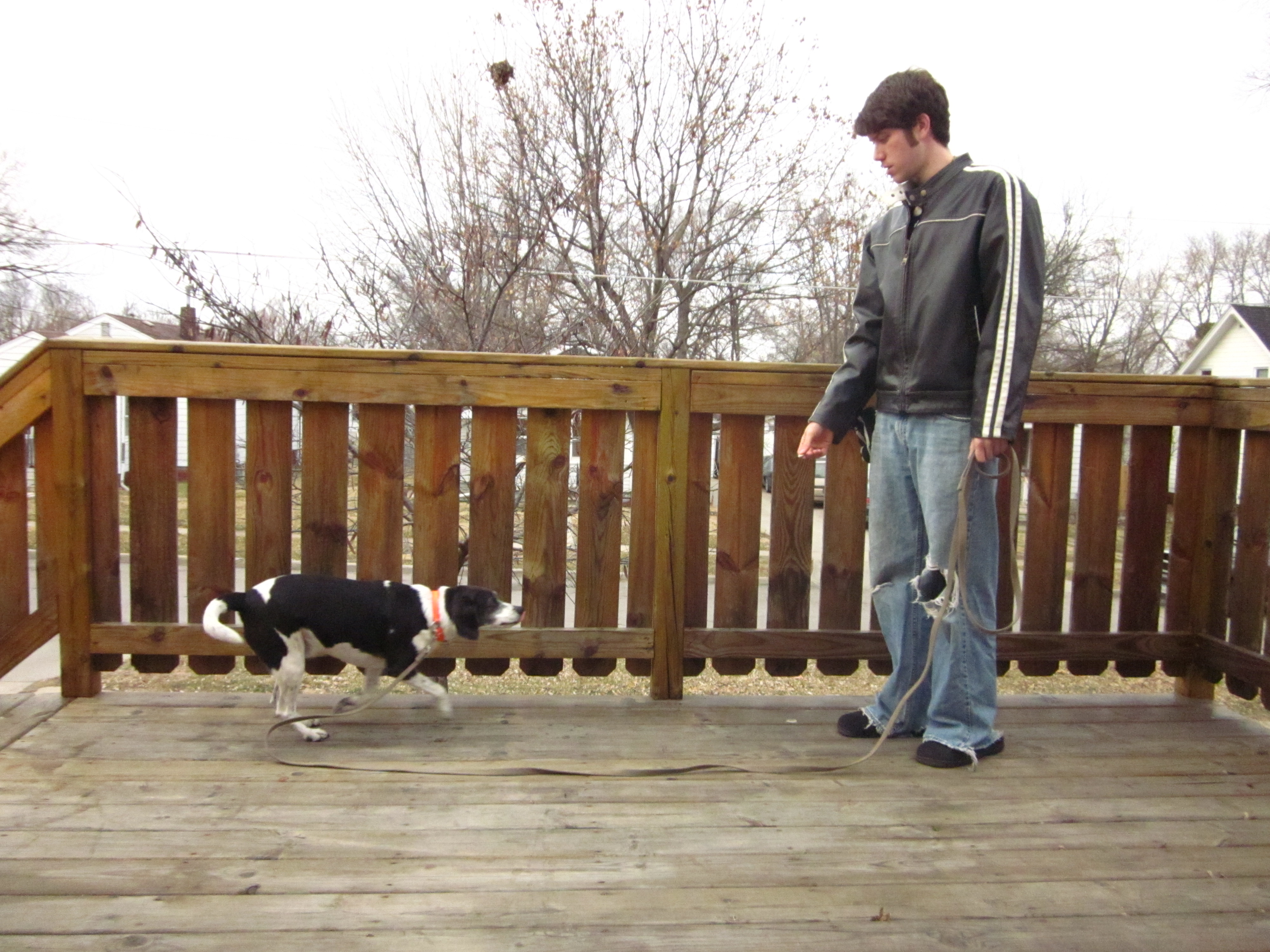
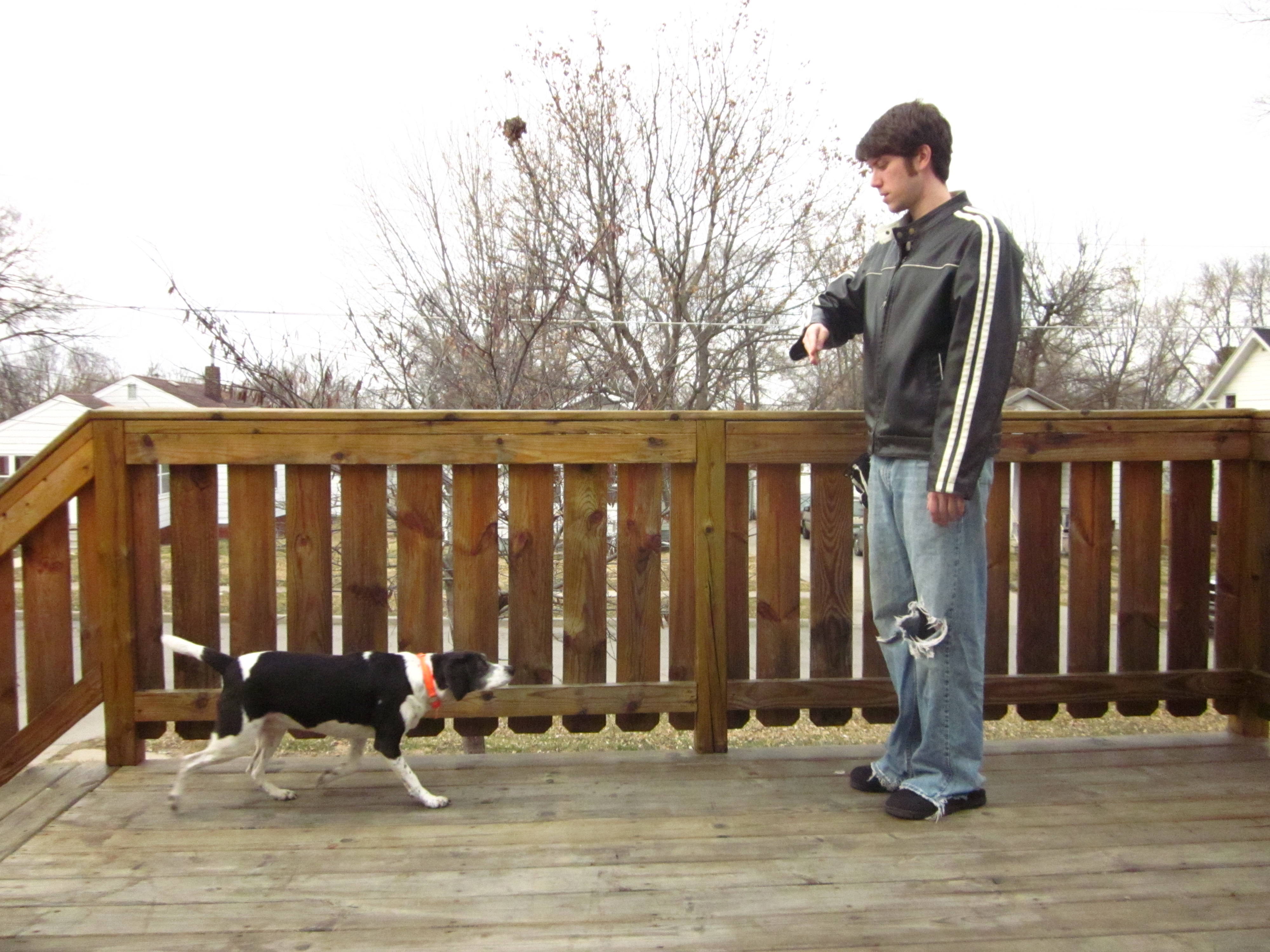
To begin working on this command your dog should already know the 'Sit' or 'Down' and 'Stay' commands. You will need a longer lead for this command.
1. With the dog in the Sit or Lay and Stay position, walk a few distance away from the dog on the long lead.
2. Firmly, but pleasantly, say 'Come' and make the hand gesture shown in Picture 2. Never pull on the lead.
If your dog is hesitant to come while you are in a standing position try crouching down to their level to increase their comfort. Once they become more comfortable following the command return to working in a standing position.
3. As soon as your dog reaches you, reward him with a treat and praise.
4. As your dog improves, you will be able to begin practice off-leash in a fenced in area. If your dog refuses to come off-leash, then return to using the long lead until he begins responding appropriately and consistently to the come command.
This is an important command for any dog owner, but especially for anyone interested in working with their dogs off-leash. Make sure not to leap ahead into off-leash situations before the command is well learned and your dog responds reliably, it could put your dog or others in a position of danger.
**Please always follow your local leash laws.
1. With the dog in the Sit or Lay and Stay position, walk a few distance away from the dog on the long lead.
2. Firmly, but pleasantly, say 'Come' and make the hand gesture shown in Picture 2. Never pull on the lead.
If your dog is hesitant to come while you are in a standing position try crouching down to their level to increase their comfort. Once they become more comfortable following the command return to working in a standing position.
3. As soon as your dog reaches you, reward him with a treat and praise.
4. As your dog improves, you will be able to begin practice off-leash in a fenced in area. If your dog refuses to come off-leash, then return to using the long lead until he begins responding appropriately and consistently to the come command.
This is an important command for any dog owner, but especially for anyone interested in working with their dogs off-leash. Make sure not to leap ahead into off-leash situations before the command is well learned and your dog responds reliably, it could put your dog or others in a position of danger.
**Please always follow your local leash laws.
Credits and Thanks

The Tutorial:
This tutorial was put together by my group and I as a project for Technical Communication English 314 at Iowa State University. If you have any questions or concerns regarding the tutorial please feel free to leave a comment.
The Credits:
All photos were taken by Brittany Stine (author).
A Special Thanks To:
My group members Gregory Yu, Jay Hong, and Josh Moore.
Our professor, Jacob Rawlins.
My fiance, Daniel Burkard, for posing in the pictures.
My dogs, Phooka and Cinder, for being cooperative (most of the time).
This tutorial was put together by my group and I as a project for Technical Communication English 314 at Iowa State University. If you have any questions or concerns regarding the tutorial please feel free to leave a comment.
The Credits:
All photos were taken by Brittany Stine (author).
A Special Thanks To:
My group members Gregory Yu, Jay Hong, and Josh Moore.
Our professor, Jacob Rawlins.
My fiance, Daniel Burkard, for posing in the pictures.
My dogs, Phooka and Cinder, for being cooperative (most of the time).